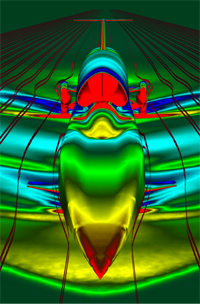The 1,000 mph engineering adventure
|
The BLOODHOUND Supersonic Car, launched by Richard Noble and Andy Green in October 2008 is set to take the land speed record into a whole new speed regime. The team, including researchers from Swansea University at its heart, plans to take a manned vehicle to 1000mph, increasing the current land speed record (763mph) by over 30%.
The target presents the team with massive scientific and engineering challenges, not least of which being how the car will stay attached to the ground at these speeds. The CFD (computational fluid dynamics) research team at The College of Engineering at Swansea University has been working on answering such questions, and predicting the overall aerodynamic behaviour of such a vehicle. The BLOODHOUND project is currently entering the build phase with vehicle completion expected in mid-2013. The car is then due to be tested in 2013 in an attempt to increase the World Land Speed Record from 763 mph to 1,000 mph. Dr Ben Evans from the BLOODHOUND team will answer both the how and the why questions related to this iconic project. |

|
Ben studied for a PhD in Computational Fluid Dynamics at Swansea University, which led to his post-doctoral research on the development of unstructured mesh techniques for high speed flows with particular application to the BLOODHOUND supersonic car. He is currently employed as a lecturer in Aerospace Engineering in Swansea University’s College of Engineering and remains a member of the BLOODHOUND SSC design team.
Date: Wednesday 9th January 2013
Time: 7pm, for a 7.30pm start
Place: Upstairs at The Lamb, 92 Lambs Conduit Street, WC1N 3LZ [gmap]
Cost: Free
One Response to “The 1,000 mph engineering adventure”
-
Jennifer Says:
January 2nd, 2013 at 8:08 pmWhy/how is this project ironic? Does that have something to do with fluids? ? ? Will try make this. Perhaps I can ask.
Leave a Reply
This site is powered by WordPress.
Science London was part of the British Science Association
